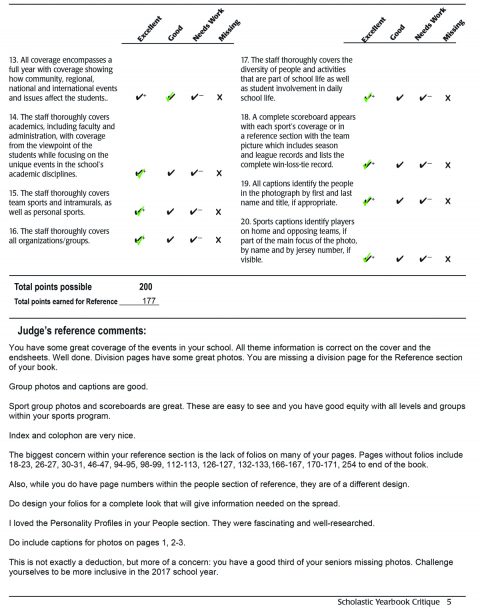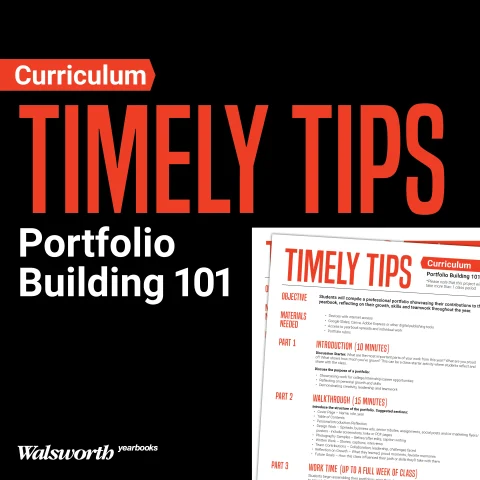How can you get better if you don’t have anyone telling you what you could improve on? It’s true that we’re often our own worst critics, but if you don’t know the rules of the game, how can you possibly know whether what you’re doing is right or wrong?
It would be akin to someone calling themselves an excellent Olympic-level swimmer because they can go a 25-yard length of the pool in 30 seconds. Nevermind the fact that they’re wearing flippers and swam the entire length under water. Without training, coaching, or critique this person just knows they swim fast and so they must be good at it.
Having your publication critiqued, whether it is your yearbook or newspaper, newsmagazine, website, literary magazine or video news production, is essential to learning the rules and applying that knowledge to the improvement of your program.
Two national organizations to send your yearbook to for critique are the Columbia Scholastic Press Association (CSPA) and the National Scholastic Press Association (NSPA). You must be members of these organizations to receive a critique, and the critique is an additional cost. These costs should come out of your yearbook budget and be paid for with the proceeds from your sales and advertisements.
Remember that your book is a professional publication whose intended shelf life is a literal lifetime. Additionally, each yearbook is a limited run as there is only ever ONE release of this publication and it can range in circulation from under 100 to more than 1,000 depending on your school.
This exclusivity means that you owe it to your audience – your buyers – to be looking to constantly improve the product they invest in.
The process
The critique process is roughly the same for CSPA and NSPA: you send your book to them, they send it to a judge, the judge looks over your yearbook page-by-page and then they send it back to you with individual comments, as well as an overall assessment of several different areas.
Both organizations have a point system with each area totaling up to a specific number of points and a range of points earning you a particular award. These points, while important if your intention is to win awards, are not the meat of the critique. It is within the comments that you will find the best resource.
How to use the criticism
First, print enough copies for yourself and your editor(s)-in-chief. Ask them to go through the written critique on their own, noting criticism that did or did not seem relevant to your program. Then, meet with just that person (or people) and go over what they feel worked and didn’t work in the previous year’s book. By the time you get your critique back it will be well into the production season of the following year, but the criticism will still be helpful and relevant.
Once you and your leader(s) decide what changes need to be made, make a plan for implementing those changes across your work flow. For example, if a criticism you received was that too many of your photographs contain people looking off the page instead of toward the gutter, devise a way to retrain your design staff to place photos with that feedback in mind. Additionally, make a change to your editing practices to catch any instances before the pages go to print.
How to help your students accept good criticism
Critique and criticism are sometimes difficult for students to accept. They are prone to go on the defensive, making excuses for why things were done that way instead of recognizing areas of potential growth. Remind your leadership before giving them the critique feedback that their staff is looking to them for how to deal with this criticism. Also remind them that a critique is the first step toward bettering your publication and that accepting the expertise of the judge is vitally important.
Once they have read over the feedback, ask them to focus on the areas that they agreed were weaknesses for your previous staff and work together with them to best help the current staff change their workflow to accommodate a new set of expectations. Knowing the criteria for an award-winning yearbook helps the entire publication take the next step toward greatness.
Another suggestion for helping your staff is reminding them of the expertise of the judges. Tell them these volunteer judges are all yearbook advisers who teach other student journalists around the country. Most of them have been advising for many years and have award-winning publications. You may also point to the depth of critique that a good judge will go to in order to help you understand the criteria and how your publication is or is not meeting it. Judges spend hours of time working on one book and you’ll know immediately if you have received a thorough critique.
What to do when you don’t agree
Always remember that scholastic journalism means that every word, phrase, picture and design choice should be included with intention. When you submit your book for critique, the judges will be expecting that your staff’s intention is to be as close to professionally journalistic as possible. There are examples of long-standing school traditions that are difficult to eliminate from your book because they are an expectation of your readership, but that are journalistically irrelevant.
Senior superlatives are an excellent example of this. Both national scholastic journalism associations agree that senior superlatives hold little to no journalistic value and often devolve into a popularity contest. If you and your staff choose to keep senior superlatives in your yearbook, you must be prepared to have a judge deduct points for it. You should prepare your staff for this.
Ultimately, you’re selling a product. Certainly you want the product to be the best it can be and offer your buyers something they can feel good about spending anywhere from $40 to more than $100 on. But, if a majority of your buyers expect senior superlatives, then you should give them what they expect. To score the most points possible and make up for something that violates the scholastic journalism criteria, you should plan to really wow the judge in another area of the book.
But what if we disagree with the whole critique?
It happens, though rarely, that a critique will arrive that you and your staff feel was either not helpful or too harsh. If very little of your book is marked or if your feedback seems generic, there are steps you can take to get a new critique. Likewise, if you feel your critique is biased in any way, there are avenues you can follow to request a new judge. If this is the case, you should visit the scholastic journalism association’s website and find the contact information for the critiquing.
Ultimately, your goal should always be to improve your publication, and the best way to do that is to learn the rules for scholastic journalism and be told where you can best improve your work!





